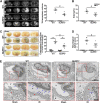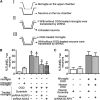NLRP3 deficiency ameliorates neurovascular damage in experimental ischemic stroke
- PMID: 24424382
- PMCID: PMC3982086
- DOI: 10.1038/jcbfm.2013.242
NLRP3 deficiency ameliorates neurovascular damage in experimental ischemic stroke
Abstract
Although the innate immune response to induce postischemic inflammation is considered as an essential step in the progression of cerebral ischemia injury, the role of innate immunity mediator NLRP3 in the pathogenesis of ischemic stroke is unknown. In this study, focal ischemia was induced by middle cerebral artery occlusion in NLRP3(-/-), NOX2(-/-), or wild-type (WT) mice. By magnetic resonance imaging (MRI), Evans blue permeability, and electron microscopic analyses, we found that NLRP3 deficiency ameliorated cerebral injury in mice after ischemic stroke by reducing infarcts and blood-brain barrier (BBB) damage. We further showed that the contribution of NLRP3 to neurovascular damage was associated with an autocrine/paracrine pattern of NLRP3-mediated interleukin-1β (IL-1β) release as evidenced by increased brain microvessel endothelial cell permeability and microglia-mediated neurotoxicity. Finally, we found that NOX2 deficiency improved outcomes after ischemic stroke by mediating NLRP3 signaling. This study for the first time shows the contribution of NLRP3 to neurovascular damage and provides direct evidence that NLRP3 as an important target molecule links NOX2-mediated oxidative stress to neurovascular damage in ischemic stroke. Pharmacological targeting of NLRP3-mediated inflammatory response at multiple levels may help design a new approach to develop therapeutic strategies for prevention of deterioration of cerebral function and for the treatment of stroke.
Figures






Similar articles
-
NOX2 deficiency ameliorates cerebral injury through reduction of complexin II-mediated glutamate excitotoxicity in experimental stroke.Free Radic Biol Med. 2013 Dec;65:942-951. doi: 10.1016/j.freeradbiomed.2013.08.166. Epub 2013 Aug 24. Free Radic Biol Med. 2013. PMID: 23982049
-
NOD2 is involved in the inflammatory response after cerebral ischemia-reperfusion injury and triggers NADPH oxidase 2-derived reactive oxygen species.Int J Biol Sci. 2015 Mar 25;11(5):525-35. doi: 10.7150/ijbs.10927. eCollection 2015. Int J Biol Sci. 2015. PMID: 25892960 Free PMC article.
-
Intravenous immunoglobulin suppresses NLRP1 and NLRP3 inflammasome-mediated neuronal death in ischemic stroke.Cell Death Dis. 2013 Sep 5;4(9):e790. doi: 10.1038/cddis.2013.326. Cell Death Dis. 2013. PMID: 24008734 Free PMC article.
-
NLRP3 inflammasome contributes to neurovascular unit damage in stroke.J Drug Target. 2019 Sep;27(8):866-875. doi: 10.1080/1061186X.2018.1564925. Epub 2019 Jan 9. J Drug Target. 2019. PMID: 30601069 Review.
-
NLRP3 inflammasome: a promising target in ischemic stroke.Inflamm Res. 2017 Jan;66(1):17-24. doi: 10.1007/s00011-016-0981-7. Epub 2016 Aug 30. Inflamm Res. 2017. PMID: 27576327 Review.
Cited by
-
Plasma Membrane Pores Drive Inflammatory Cell Death.Front Cell Dev Biol. 2020 Aug 21;8:817. doi: 10.3389/fcell.2020.00817. eCollection 2020. Front Cell Dev Biol. 2020. PMID: 32974349 Free PMC article. Review.
-
Significance of Melatonin in the Regulation of Circadian Rhythms and Disease Management.Mol Neurobiol. 2024 Aug;61(8):5541-5571. doi: 10.1007/s12035-024-03915-0. Epub 2024 Jan 11. Mol Neurobiol. 2024. PMID: 38206471 Review.
-
MCC950, a selective NLPR3 inflammasome inhibitor, improves neurologic function and survival after cardiac arrest and resuscitation.J Neuroinflammation. 2020 Aug 31;17(1):256. doi: 10.1186/s12974-020-01933-y. J Neuroinflammation. 2020. PMID: 32867797 Free PMC article.
-
Targeting the pathways of regulated necrosis: a potential strategy for alleviation of cardio-cerebrovascular injury.Cell Mol Life Sci. 2021 Jan;78(1):63-78. doi: 10.1007/s00018-020-03587-8. Epub 2020 Jun 28. Cell Mol Life Sci. 2021. PMID: 32596778 Free PMC article. Review.
-
Qingkailing injection ameliorates cerebral ischemia-reperfusion injury and modulates the AMPK/NLRP3 Inflammasome Signalling pathway.BMC Complement Altern Med. 2019 Nov 20;19(1):320. doi: 10.1186/s12906-019-2703-5. BMC Complement Altern Med. 2019. PMID: 31747940 Free PMC article.
References
-
- Saleh M. The machinery of NOD-like receptors: refining the paths to immunity and cell death. Immunol Rev. 2011;243:235–246. - PubMed
Publication types
MeSH terms
Substances
LinkOut - more resources
Full Text Sources
Other Literature Sources
Medical
Miscellaneous

